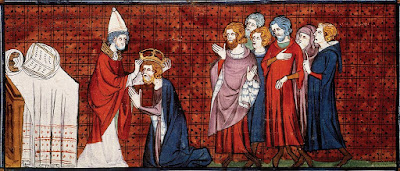Honorius died on 13 February 1130, and six cardinals quickly appointed Gregorio as the next pope, consecrating him the very next day and supported by the powerful Frangipani family. This was highly irregular (only six cardinals!), and a larger group of cardinals chose Pietro Pierleoni, whose family was the enemy of the Frangipani, as Pope Anacletus II. Anacletus was able to drive Innocent from Rome.
The conflict between the two went on for years until Anacletus died in 25 January 1138. This did not make Innocent's life conflict-free, however. Roger of Sicily opposed him, especially after Innocent had him excommunicated at the Second Lateran Council (Innocent was not alone in objecting to Sicily being in Roger's possession). Roger's son, Roger III of Apulia, captured Innocent and forced him to acknowledge the kingship of Sicily.
Among Innocent's decisions was a papal bull in 1139 declaring that the Knights Templar should be only answerable to the papacy. He established ties with Armenian Catholics and began the process of ending the schism between Armenia and Rome. He also made cardinals of several of his nephews.
The Second Lateran Council (or "Second Council of the Lateran") was Innocent's attempt to unify policy across Roman Catholicism. Some of the canons established were mentioned here. Besides the prohibition against tournaments and jousts,
Kings were to dispense justice with the advice of bishops
Lay people who did not pay tithes were to be excommunicated
After a bishop died and a church was vacant, a replacement must be found within three years
The use of bows or slings against Christians was prohibited.
Clergy were not allowed to accept a benefice from a layman that would obligate them to the layman.
When Innocent died on 24 September 1143, he was interred in a sarcophagus the supposedly once held the body of Emperor Hadrian.
The Anglo-Saxon Chronicle says that the original Britons came from Armenia, and Armenia has been mentioned many times over the course of this blog, but we've never talked about the Armenian Church before today. Next time, let's look at where it came from and its connection (or lack thereof) to Rome.



